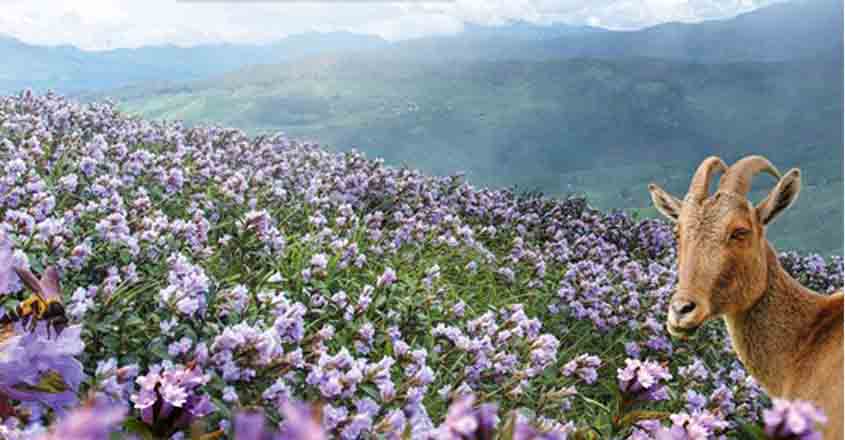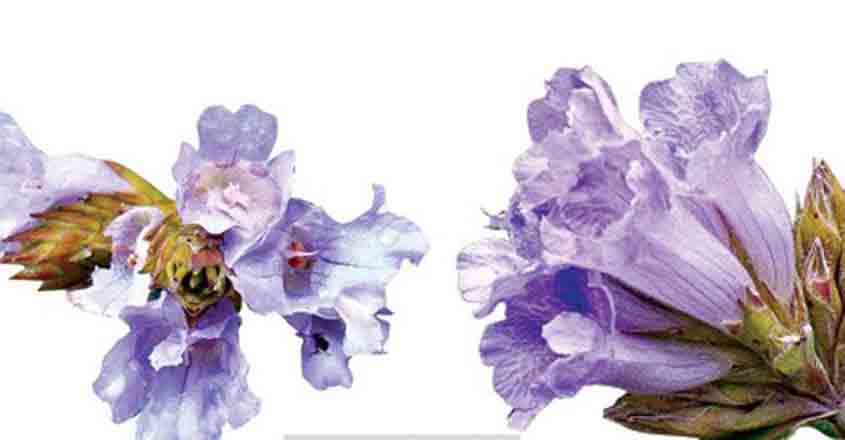
The purplish blue hue the flowers lay out like a carpet seems to mirror the azure sky above the mountain rolls of Munnar. It's at an odd time this hill station celebrates its mega spring. The once-in-12-year burst occurs towards the end of a monsoon! It colours the earth for a good three months starting from September.
Extending beyond the misty layers bordering the horizon, the 'neelakurinji' blooms endlessly on this stretch of the Western Ghats. It's a sight that brings thousands of people atop the mountains, where these flowers weave magic from dawn till dusk at an altitude ranging between 1,300 to 2,400 metres.
The sight at Rajamala bordering Tamil Nadu is surreal. So much so, even the sun here seems like a lazy star. The rays don't reach here promptly by the turn of day. Even if they do, the bright clouds act as a silvery filter. In short, it is by 7.30 when morning actually sets in on the hills.
"The indolence of the nature percolates into the minds of tourists here. You don’t find many early risers around,” says local resident Tiruthi Rajendran, draped in woollens and sipping tea at a neat shack overlooking a valley. “Once they are up from the bed, it dawns upon them that the day’s schedule is busy. One has to cover a lot of exciting places: Mattupetty, Top Station, Devikulam, Gap Road, Kolukkumala, Kundala, Vattavada.... Now, that’s going to be rigmarole."
Even if you reach the 'neelakurinji' hills a bit late, sunlight won’t yet be golden but ashen-blue. That is the best time to enjoy the sight. To roam about in the slight chill, to wade a bit into the Muthirappuzha that is a confluence of three rivers, to come out and knock down the drops of dew hanging on to tips of leaves around. After all, 'neelakurinji' is no daily sight. It happens once in a Jupiter year, lasting for less than a sweet hundred days. A kind of clock the nature keeps. So prompt that a certain tribe in the locality used to go by the 'neelakurinji' bloom to calculate the age of its people.

Munnar surge
With its tea gardens the British initiated to raise during their rule, Munnar still is a cute little region with a Raj-era hangover. To be true, it didn’t enjoy the status of a tourist paradise till, say, a quarter century ago. To be precise 24 years ago. That time, in 1994, when the 'neelakurinjis' bloomed, tourists flocked to Rajamala like never before. Suddenly, the focus was to the velvety violet spread of the flowers instead of the green tea gardens that was otherwise the cynosure in what little measure till then. Rajamala means ‘kingly mountains’, but in effect its top became commoners’ paradise when the flowers bloomed.
Official records speak of the 'neelakurinji' bloom way back from 1838. Only that it took one-and-a-half century’s time further for Munnar’s once-in-12-years flowers to fetch the belt a visible mark on the country’s tourist map. The 1994 bloom lent Munnar the status of a southern Kashmir in hilly Kerala. Roads leading to the 'neelakurinji' hills dramatically began gaining strength and breadth. Its base camp saw a spurt in hotels, many of them with star status. In 2006, when the next round of flower-burst happened, lakhs of people paid visit to take in the breathtaking sight. A good portion of them came from abroad. The nature’s rare flower festival had become a global hit.
Even so, this year’s bloom is special. For, it has come for the first time since social media and communication technologies gained such degree of popularity and penetration among the general public. Information revolution has instilled hopes of a much higher attendance at the Rajamala hills to see the flower-burst. When the season ends, no less than eight lakh people would have dropped by, according to official projection.
The 'neelakurinji' blooms not just in a particular spot, to be clear. Gap Road, for instance, is among several places where the flower gives sight, though in smaller measures. The Eravikulam National Park, which includes Rajamala hills, has them in abundance. The 100-sqkm sanctuary, which is a UNESCO World Heritage Site with its rare mix of flora as well as fauna, is also noted for the Nilgiri tahr. It is an endemic variety of wild goat, stocky and short with coarse fur and bristly mane. Locally, it’s called varayadu (and varaiyaadu in Tamil).

Both genders of this animal possess horns. "It is quite a sight to notice them holding their heads high...enough to be seen above the 'neelakurinji',” says trekker Jibu Jacob, who is a regular at the Rajamala, with his camera slung from one shoulder. “It takes only moments for them to climb up a rocky hill. Atop it, they sometimes get into a duel, locking horns. That’s, again, another exhilarating sight."
That apart, the tahrs are peaceful creatures, he says. "This goat lets you go near it and even touch it for long. Only that it might invite a fine because the forest guards would notice the act and penalise you," Jibu adds. “The tahr has generosity that our officials sadly don’t have."
Heavenly flower
The tribal people living in Rajamala and its surroundings consider 'neelakurinji' a sacred flower. To them, this bloom festival is a blessing from Muruga, the lord of hills. After all, it’s with 'kurinji' flowers he garlanded Valli, or so goes the lore. The once-in-12-years spring on Rajamala hills makes its natives busy with certain propitiatory rites and offerings. The honey that gets collected from the flowers, too, has a blue colour.
Once the season ends with the flowers wilting, Rajamala gets back to its bare terrain. That entails a wait of another 12 years. “For us, thus, the 'neelakurinji' bloom suggests good times,” says Muthu Raj, a member of the local Muthuvan tribe. “That is why we used to calculate our age using the season as the measure. If we used to say someone has seen four kurunji seasons, it means he/she lived at least 48 years.”
Royal Rajamala
The gateway to Eravilkulam National Park is 15 km northwest of Munnar town. It’s there you get entry tickets, manually. Else they are available online. On gaining entry, you are taken in a mini-bus run by the forest department. It's trip down green tea gardens. Halfway to the Rajamala hills, the 'neelakurinji' blooms become visible. So do the Nilgiri tahrs moving about in herds. The nature around is enchanting.
Close to the hilltop, you get down at the check-post and trek two kilometres up. There you can wander about, taking in the rare sights and storing them both in your mind and camera. There are people, perhaps just curious, who pluck flowers as a souvenir to take home. For them, a word: the 'neelakurinji' flowers droop within half an hour after they are plucked. If your plan is to uproot a plant or two to groom them in the front yard of your home, well, neelakurinjis don’t grow anywhere beyond the Rajamala soil. In short go by the forest department officials’ words of wisdom: “Only steal glances at them. No point pilfering. Take back just handful of good memories.”
A 'neelakurinji' flower lasts an average of 45 days. During that span, it keeps busy the butterflies and honeybees around. Once the whole season gets over, the 'kurinji' plants dry up. Their seeds droop, lending themselves fodder to the forest birds and wild hen.
The wilt marks the start of a 12-year wait. For the poet, it’s the time the 'neelakurinji' plants meditate about another round of colourful return. In petty human calculation, that is till 2030.

